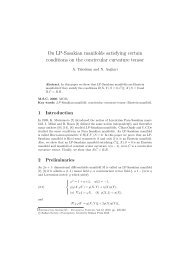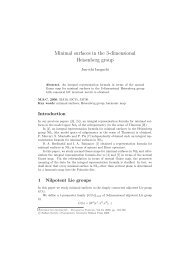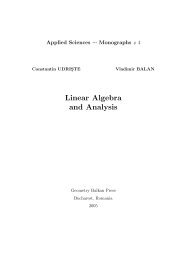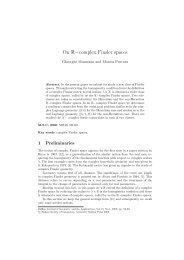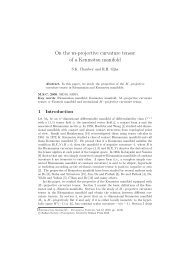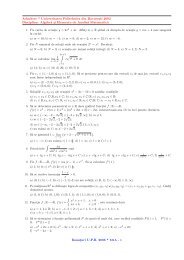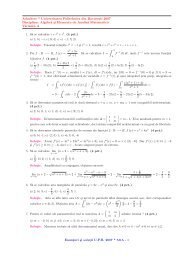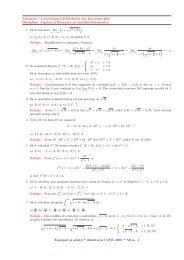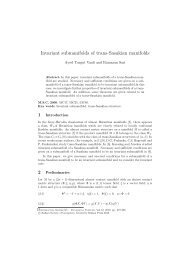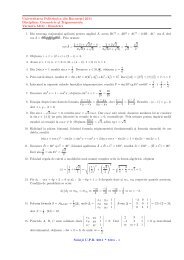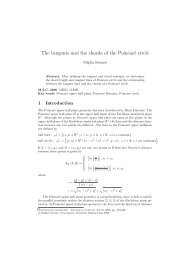Semigroup of generalized inverses of matrices
Semigroup of generalized inverses of matrices
Semigroup of generalized inverses of matrices
Create successful ePaper yourself
Turn your PDF publications into a flip-book with our unique Google optimized e-Paper software.
<strong>Semigroup</strong> <strong>of</strong> <strong>generalized</strong> <strong>inverses</strong> <strong>of</strong> <strong>matrices</strong> 151( )Q be two nonsingular <strong>matrices</strong> such that A = Q −1 Ir 0P . Then it is sufficient( )0 00 0to take A ′ = Q −1 P with w ∈ M0 w(m−r)×(n−r) (K) andrank(w) = min (m, n) − r.b) Let rank(A) = r, rank(B) = s. According to 1, there exist <strong>matrices</strong> A ′ andB ′ ∈ M m×n (K) <strong>of</strong> ranks min (m, n) − r and min (m, n) − s such that rank (A + A ′ ) =rank(A) + rank(A ′ ) = min (m, n) and rank (B + B ′ ) = rank(B) + rank(B ′ ) =min (m, n). It follows that (A + A ′ ) {1} ⊂ A {1} ∩ A ′{1} , (B + B ′ ) {1} ⊂ B {1} ∩ B ′{1} .Since A + A ′ , B + B ′ have the same rank, they are equivalent. So, there existsan isomorphism ϕ from A {1} on ϕ ( A {1}) (such that ϕ (A + A ′ ) {1}) = (B + B ′ ) {1} .Hence we have(ϕ (A + A ′ ) {1}) (⊂ ϕ A {1} ∩ A ′{1}) (= ϕ A {1}) ∩ ϕ(A ′{1})(and ϕ (A + A ′ ) {1}) ⊂ B {1} ∩ B ′{1} . Finally, we have ϕ ( A {1}) ∩ B {1} ≠ ❢ . □The natural question arises whether it is possible to conclude that for any <strong>matrices</strong>A, B ∈ M m×n (K) we have A {1} ∩ B {1} ≠ ❢ . The answer is negative. In fact if wetake B = αA for a scalar α which is different <strong>of</strong> 1 and 0, then if X ∈ A {1} ∩ B {1} ,we have αA = αAXαA = α 2 A. Thus α ∈ {0, 1} which contradicts our assumption.Consequently we have A {1} ∩ B {1} = ❢ .3.2.3 Partial order in M {1}m×n (K)Definition 3.1. ([5]) A minus partial order, denoted by ≺ − , is defined as follows forA, B ∈ M m×n (K), then A ≺ − B if rank(B) = rank(A) + rank (B − A).Theorem 3.6. 1) The inclusion is a partial order in M m×n(K) {a} induced by the minusorder in the reverse order.b) Let m 0 = min (m, n). For any matrix A ∈ M m×n (K) <strong>of</strong> rank r there exists asequence <strong>of</strong> <strong>matrices</strong> A = A r ≺ − A r+1 ≺ − .... ≺ − A m0 in M m×n (K) such thatrank (A r ) = rank (A) = r, rankA r+i = r + i for i = 1, ...m 0 − r. Thus, there existsa sequence A {1}m 0⊂ · · · ⊂ A {1}r = A {1} and A {1}m 0is the last term.Pro<strong>of</strong>. a) For A, B ∈ M m×n (K), if A ≺ − B, then rank(B) = rank(A)+rank (B − A).By Lemma 3.2 it follows that B {1} ⊂ A {1} . Hence we have the partial order ⊂ inM m×n(K). {1} b) Let {v 1 , v 2 , ...v r } be a basis <strong>of</strong> R(A) and {v r+1 , v r+2 , ...v m } be suchtogether with the basis <strong>of</strong> R(A) form a basis for K m . Let {e 1 , e 2 , ...e n } be a basis forK n such that A r e j = Ae j = v j for j = 1, ...r and A r e j = 0 for j = r + 1, ...mand for i = 1, ...m 0 − r, A r+i e j = v j for j = 1, ...r + i and A r+i e j = 0 forj = r + i + 1, ...m. ( In these ) bases the <strong>matrices</strong> ( A = ) A r and A r+i are <strong>of</strong> the formA = A r = Q −1 Ir 0P , A0 0r+i = Q −1 Ir+i 0P for i = 1, ...m0 00 − r. Thenwe have rank (A r ) = rank(A) = r , andrank (A r+i ) = rank (A r ) + i = r + i = rank(A r ) + rank (A r+i − A r ) ,



